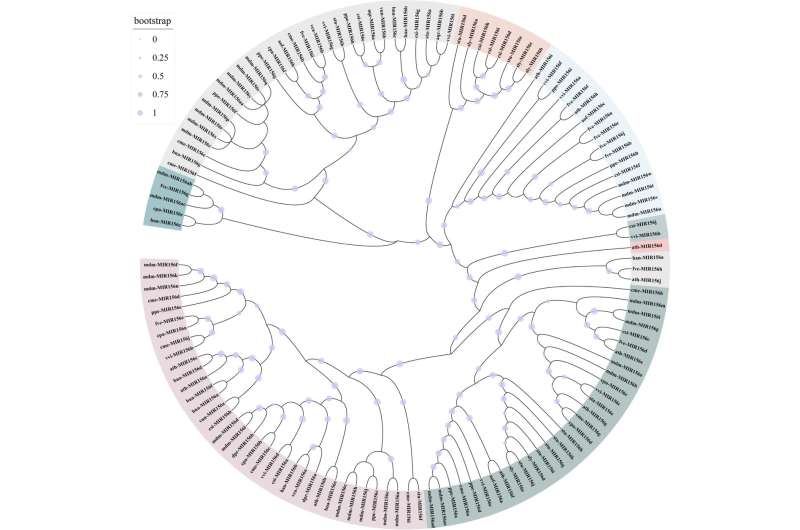This article has been reviewed according to Science X's editorial process and policies. Editors have highlighted the following attributes while ensuring the content's credibility:
fact-checked
trusted source
proofread
Exploring the multifaceted role of MicroRNA156 in horticultural plants

A research team has reviewed the role of MicroRNA156 (miR156) in horticultural plants, uncovering its significant influence on a variety of biological processes such as vegetative growth, floral induction, and stress response. miR156, known for its high conservation across plant species, holds great promise as a biotechnological tool for enhancing horticultural traits.
The study emphasizes the potential of miR156 to expedite the juvenile stage in perennial plants, thus improving quality and yield. Future research is poised to delve into the complex regulatory mechanisms of miR156, aiming to fine-tune its application in developing desirable traits in economically important horticultural plants.
MicroRNAs are a class of endogenous non-coding RNAs that negatively modulate gene expression in plants by affecting mRNA cleavage and translational repression. MicroRNA156 (miR156), is one of the most evolutionarily conserved miRNAs among angiosperms, initially discovered in Arabidopsis and now identified in numerous horticultural plants, as catalogued in the miRBase database.
It influences various horticultural traits and serves as a potential tool for biotechnological modifications. However, despite its widespread functional verification, the complex interactions and regulatory mechanisms of miR156 remain largely unexplored. Addressing these gaps is essential for harnessing the full potential of miR156 in horticultural advancements.
A review article published in Ornamental Plant Research on 2 April 2024, summarizes the multifunctional regulation of miR156 in horticultural plants and explores potential avenues for future research.
Based on 141 sequences from 16 horticultural plants, miR156 members belong to 26 subfamilies (miR156a–z). Their sequences show great conservation, according to the alignment of miR156 subfamilies from different horticultural plants. SPL transcription factors are the target of miR156.
Previous studies have revealed that the miR156-SPL module could engage in multiple important biological processes, such as vegetative phase change, flower development, fruit ripening and stress responses. The miR156-SPL module also works synergistically with other signaling pathways, like glucose signaling, T6P pathway and phytohormones signaling.
At the same time, the researchers also summarized the functional validation techniques for miR156 in horticultural plants, including overexpression, expression suppression, and CRISPR/Cas9 technology. Despite the diverse functionality of miR156, its mechanisms remain underexplored, particularly in non-model horticultural plants with unique traits like tuberization in potatoes or tendril formation in cucumbers.
The review highlights the need for deeper research into miR156's interactions with SPL transcription factors and other signaling pathways to fully leverage its biotechnological potential. This review ultimately sets the stage for future studies to explore the regulatory complexities of miR156, aiming to harness its potential for improving the quality and productivity of horticultural plants.
According to the study's senior researcher, Yun Wu, "Here, we summarize the functional diversity of miR156 in horticultural plants to provide new insights for further research on the biological function and regulatory mechanism of miR156 and on how to employ miR156 to achieve the enhancement of horticultural traits."
This review delves into the multifaceted roles of the miR156 family across a spectrum of horticultural plants, showcasing its evolutionary conservation and significant function in regulating developmental traits.
More information: Yunchen Xu et al, MicroRNA156: a count up timer with potential to enhance horticultural traits, Ornamental Plant Research (2024). DOI: 10.48130/opr-0024-0008
Provided by Chinese Academy of Sciences




















